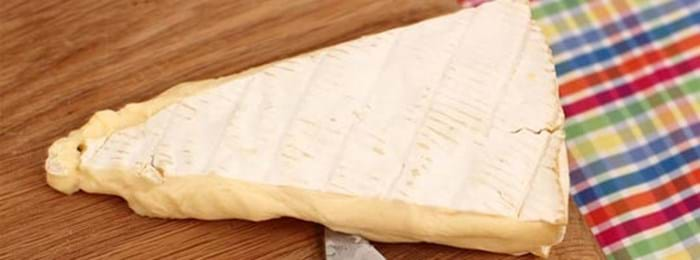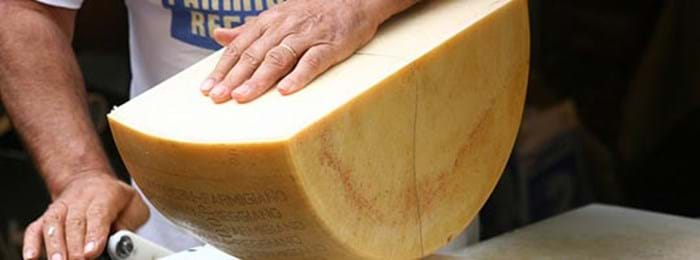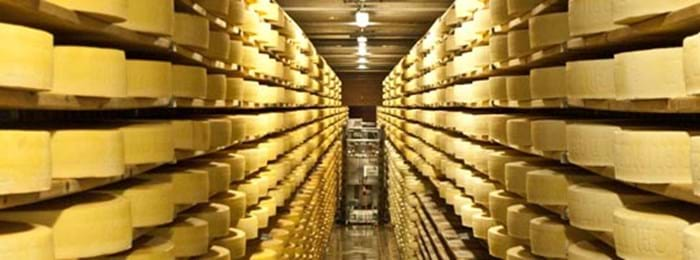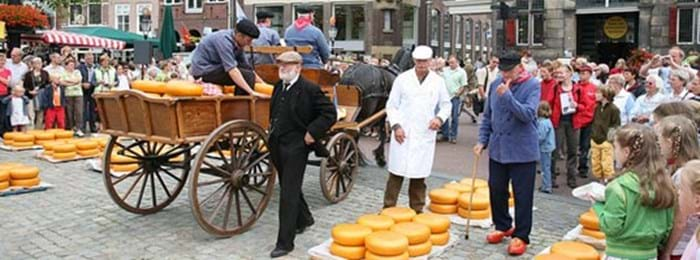Europe’s most delicious cheeses
When it comes to cheese, Europe has one of the best selections in the world. From the delicious world of French fromage, to the mature flavours of Switzerland, whether it's creamy and soft, or hard and tangy, nothing quite beats Europe's love for cheese. To help you get inspired for your next trip across the Channel with LeShuttle, we've put together a guide to touring the continent's top cheese destinations. So, grab your guide and your satnav, and get ready for the cheese holiday of a lifetime.
Begin your journey with the cheeses of France

Drive west to Normandy
From Calais, you can begin your cheese tour by heading west to Normandy, the original home of Camembert. The first ever Camembert was produced by Marie Harel, in 1791, using raw cow's milk, and only those who produce the cheese in the same way as Harel have the legal right to naming it Camembert. Once matured, Camembert has a creamy, buttery taste, with a pale yellow interior and bloomy rind, and goes perfectly with roasted garlic and baguettes, as well as a glass of Normandy cider.
If you want to find out more about Camembert during your trip to Normandy, be sure to spend a day visiting La Maison du Camembert. This museum and farm allows visitors to explore the history of the cheese, as well as learn all about how it's made.
Cruise down to Brie
Once you've had your fill of Camembert, hit the road and drive down to the Brie region, specifically the town of Meaux, home of the famous Brie de Meaux cheese, a delicious type of Brie cheese that's unpasteurised. Made from cow's milk, this creamy, straw-coloured cheese has a sweet, buttery taste and a bloomy, white rind. Brie de Meaux is matured in specific regions of France, from Seine-et-Marne to Yonne, so be sure to head to the listed regions for a taste of the real thing.
When cooking with Brie, be sure to complement the flavours of your meal with a flute of champagne, or for something richer, a glass of red Bordeaux.

Continue your journey down to the Auvergne region
No cheese tour of France would be complete without a stay in the Auvergne region, the home of the Bleu d'Auvergne. Awarded AOC (Appellation d'Origine Contrôlée) status in 1975, this popular cheese is encased by a bloomy rind and has an earthy flavour, with blue-green veins rippling through its ivory-coloured interior. The strong taste of Bleu d'Auvergne complements the leafy base of any salad, and if eaten alone, a French dessert wine will work perfectly with the tangy flavours of the cheese.
Finish your French cheese journey in Roquefort
If you're a fan of blue cheese, take your tour of French cheeses down south to Roquefort, for the cheese of kings and popes. According to EU law, only when the Roquefort cheese is matured in the natural Combalou caves of Roquefort-sur-Soulzon, can the cheese be named Roquefort, so be sure you keep an eye out for the real thing.
On average, this crumbly cheese is aged for five months, with the end result being a sharp and salty, white and blue cheese that works well in Southern-French salads.
Drive west for formaggio in Italy

Begin your Italian journey in Bergamo
From Roquefort, head west to Italy, where your first stop should be Bergamo, one of many places you can find a working mozzarella farm. Quattro Portoni Caseificio produces over 20 types of cheese, but with a substantial buffalo farm located on the estate, many flock to sample a fresh ball of mozzarella di bufala, or buffalo mozzarella.
The creamy, milky flavour of the cheese goes perfectly with a tomato and basil salad with lashings of extra virgin olive oil, but it's also a popular topping choice for traditional, Italian pizzas.
Drive south to Parma
Not only is Parma the home of delicious ham and incredible architecture, it's also well known for the Parmigiano Reggiano cheese. According to the strict rules of PDO (Protected Designation of Origin), for the cheese to be officially Parmigiano Reggiano, the milk used must be from cows that have fed on the fresh grass and hay of Parma.
Once matured, the cheese has a crystallised texture, with a natural rind, straw-coloured interior and a fruity, nutty taste. Many Italians grate the cheese finely over warm dishes, including pasta and minestrone soup.
Continue towards Tuscany
After your stay in Parma, head further south to Tuscany, where you're likely to enjoy plenty of Pecorino Toscano, wherever you find yourself in the region. One of many types of Pecorino (with others being Pecorino Sardo and Pecorino Romano, both from Sardinia, and Pecorino Siciliano, from Sicily) this hard cheese is made from ewe's milk, and has a creamy-yellow colour, and a buttery, nutty flavour. When cooking or dining out, it makes for the perfect accompaniment to any Italian spring salad.
Head north for a taste of Swiss cheese

Stop off in Fribourg
From Tuscany, make the journey up north to Switzerland, to the canton of Fribourg, where one of the best types of Gruyère cheese is produced, Le Gruyère Premier Cru. Matured in humid caves in Fribourg for 14 months, the cheese has an earthy and nutty flavour, a rusty brown rind and semi-soft texture that's won the World Cheese Awards in London a total of four times. A true luxury in the world of cheese, and a must-try on any cheese tour of Europe.
Continue up to Emmental
From Fribourg, make your way back up to the region of Emmental, the home of Emmentaler cheese. Although easily recognisable because of the holes that run through the cheese, these famous holes are also one of the reasons why it's one of the most difficult cheeses to produce. According to the AOC, to be correctly named Emmantaler, the cheese must be aged for four months, where it will be left with a hard, natural rind.
When eating, Emmantaler works perfectly with thick slices of ham in a buttered baguette, yet one of the more popular choices in Switzerland, is to mix it with Gruyère in a pot of fondue.
Finish your journey with a slice of Dutch kaas

Enjoy a whistle stop tour of Westerkwartier cheese
Westerkwartier is one of the two provinces that Kanterkaas, according to its PDO, can be traditionally made, with the second being Friesland. Two types of Kanterkass are popular in the Netherlands; the first is Kanter Komijnekaas, a type of hard cheese that is seasoned with ground up cumin. The second is Kanter Nagelkaas, a cheese that is also flavoured with cumin, but also nutmeg, adding a slightly sweet, spicy taste to it.
End your cheese tour in Gouda
Named after the city itself, Gouda is one of the most popular cheeses in the Netherlands. One of the best places to grab a wheel of Gouda for yourself is at the Cheese Market, which is located just outside of the Gouda City Hall. Rows and rows of Gouda wheels are stacked up high at each of the market's stalls, providing cheese lovers with varied Gouda types, from the young Graskaas cheese, to the extra-aged Overjarig that often has a black outer rind.
Getting there and around
If this cheese tour of Europe has got you inspired for a holiday with a difference, then be sure to book your tickets today. Crossing the Channel with LeShuttle takes just 35-minutes, meaning that you can be on the cheese-laden roads of Europe in no time at all.
Book your journey